I want to live, damn it.
Last week at the grocery store, though, I found a "simple canning and preserves" magazine by the register. "Simple" sounded hopeful. Boiling water is simple. Pouring milk on cereal is simple. That Carnation "famous fudge" kit is supposed to be simple, but we all know that's a vicious lie. Could it be possible that preserves, pickles, and jelly could also be simple? People on "Chopped" are often making a quick pickled vegetable, and even though they're trained professional chefs they're still doing it in thirty minutes, so really, maybe it didn't have to be as difficult as that sauce cookbook made it seem.
It's not.
The magazine taught me about refrigerator pickles. All the intimidating parts of pickling are removed in this process, where you boil some vegetable, pour some hot pickling liquid over it, and let it sit in the refrigerator for an hour or two. You can do it in a jar, or a bowl, or in something like this green Tupperware pickle keeper that my dad used to use all the time when we were little. (Mom, if you still have that thing and Dad isn't using it anymore, as I suspect he isn't since I don't recall seeing it in the last decade or two, can I have it? Or can you check with your Tupperware lady and see if they still make something like that?)
Armed with a recipe and a sense of ease (the recipe was so simplified, in fact, that it informed me that "the water is boiling when it starts to bubble rapidly"; how could I screw something up that's dumbed down this far?), I got to work boiling my beets:
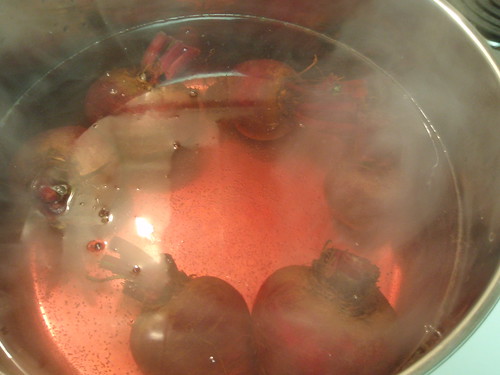
and watching the color leak out of them. By the time it was done, the water was a dark, murky purple, but the boiled beets looked a little rough:

until they were peeled and sliced:
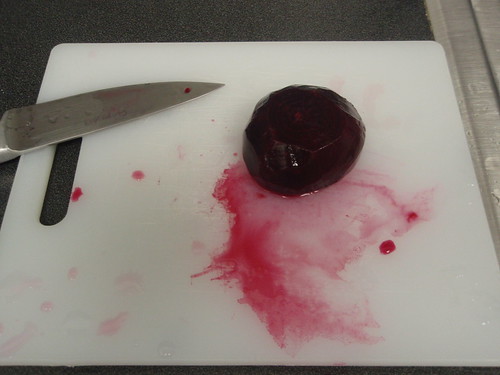
The recipe told me that the peels would slip right off, but this was a lie, and I ended up using a vegetable peeler. After that I sliced them thin, although my slices are a little uneven since I don't have a mandolin (and don't want one; I guarantee that I will slice a fingertip off with one of those) and it didn't occur to me to use the food processor to slice them. Thinking about it, the disaster potential of beet juice spraying across my kitchen means I'll just keep using a knife.
After the beets were sliced and piled in my jar, I boiled the pickling liquid:
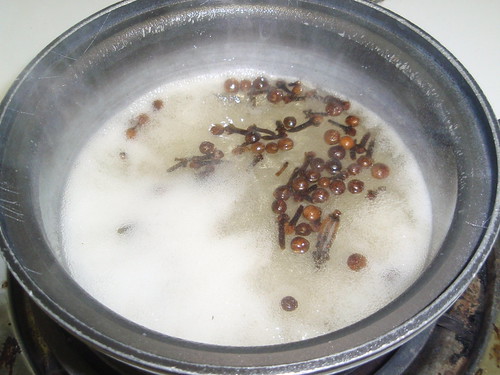
The pickling liquid is mostly vinegar. You should avoid leaning directly over it to take pictures of it boiling. Go ahead and take my word for that, and don't try it at home unless you have a sinus infection and really need your pipes cleaned out.
Once the liquid was boiled, I poured it into the jar:
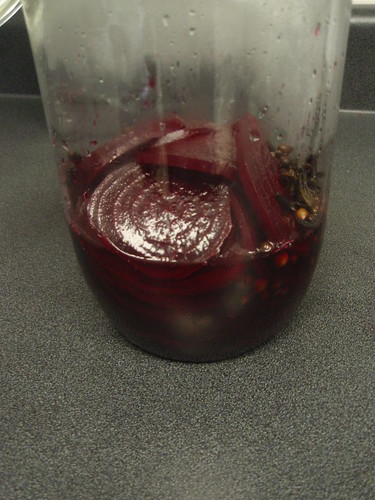
(that's only half the liquid; I stopped pouring to take a picture) and ignored it for an hour and a half before coming back to see what it looked like:
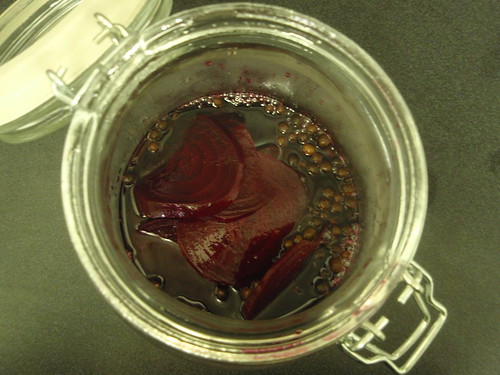
I sifted the slices out with a slotted spoon, and dug in:


The color against the white plate is so pretty, a mix of red, purple, and magenta depending on how deep it is. As for the flavor, if you don't like beets, this isn't going to be the dish that changes your mind. Cold beets have more intense flavor than warm beets (in my opinion), and there's also a tang to this that I found really declicious. It almost seems to have an undertone of citrus, which is odd since there isn't any citrus involved, but it might just be the acidity of the pickling liquid mixing with the sugar and sweetness of the beets.
As for that cookbook, there are some dilled pickled carrots in there that seem like a real possibility for deliciousness.
Of the vast numbered of pickled things my parents produced, beets were my favorite. Thanks for bringing back the memory.
ReplyDeleteAs a beet hater, I have to say that looks super disgusting. But, it was a pleasure reading your experience. I am glad you lived and did not poison yourself!
ReplyDeleteOddly, I love some things pickled, and hate others. Crunchy dill pickles - yes. Pickled eggs - no. Pickled radish (as in Korean kimchi) - yes. Pickled beets - no. British Branston Pickle, pickled peppers, and olives - yes. Pickled tomatoes - no.
ReplyDeleteI think the "no" items are foods that I've been used to eating a different way already, and so the violent taste change is disturbing to my brain. The yes foods are foods that I've only ever had that way.